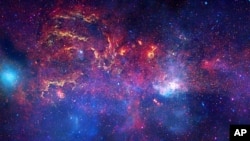Researchers in the United States say they have identified more than 675 rogue stars on the outskirts of our Milky Way galaxy that appear to have been ejected by the immense gravitational forces at the galaxy's core.
In general, astronomers use the term supermassive black hole to identify the gigantic area believed to sit at the center of nearly all large galaxies, including the Milky Way.
Researchers at Vanderbilt University, in the state of Tennessee, say their observations indicate the hundreds of stars they identified are Sun-like hypervelocity stars in the late stage of their evolution, known as red giants. Hypervelocity stars are believed to have once been part of a binary or twin system that strayed too close to the supermassive black hole which reacts by devouring or capturing one star, and flinging the twin out of the galaxy.
The hypervelocity stars identified in the new Vanderbilt University-led study were kicked out of the Milky Way galaxy at an estimated speed of around 3.2 million kilometers per hour.
The astronomers say they determined the rogue stars originated from the center of the Milky Way by observing their location in space and their distinctive red coloring, which is a chemical signature for celestial bodies formed in the galaxy's inner regions.
The scientists say that studying these stars can provide insight into the history and evolution of the Milky Way galaxy.
The new study is published in the May issue of Astronomical Journal.
The supermassive black hole at the Milky Way’s galactic core is estimated to have a mass four million times greater than the Sun's.
In 5 to 6 billion years, the Sun will begin to run out of its hydrogen fuel and expand into a Red Giant before ultimately blasting off its outer layers to end its evolutionary life as a relatively small and dense white dwarf star.
News
Ejected Milky Way Stars Found in Intergalactic Space






